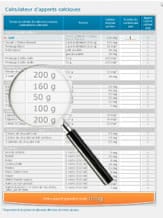
Bone is living tissue in perpetual renewal. This bone remodelling constantly weighs the demolition and reconstruction processes against one another and there are three major stages during the course of life:
- growth during the first 20 years: formation of bone mass, the formation being greater than the resorption,
- plateau: a period of balance between the two phenomena, - bone loss: The loss is 0.5 to 1% per year with a phenomenon that accelerates in women after the menopause.
Thus, the more the initial bone mass is significant the more subsequent risk of complications is kept under control.
From childhood, calcium intake should be sufficient; and the intake should be adjusted and maintained in adulthood. A sporting activity, also beneficial to bone healing, can be recommended.
Similarly, sun exposure is to be favoured in order to produce vitamin D.
Calcium intake recommendations according to age:
| Age group | Recommended intake (mg/day) |
| Children : 1 to 3 years | 500 mg |
| Children : 4 to 9 years | 800 mg |
| Teenagers : 10 to 18 years | 1 200 mg |
| Adults over 18 years | 900 mg |
| Women over 55 years | 1 200 mg |
| Men over 65 years |
Source : AFSSA
Calcium intake calculator
How do you know if calcium intake is sufficient?
The recommended intakes have been defined according to age and calcium content of foods is now well known.
It is therefore possible to estimate the amount of calcium absorbed by your patients in their diet, using the "calcium intake calculator". This test can be carried out at any age and is worth repeating with the changes in seasons that influence eating habits and make them vary.
This calculation only takes a few minutes but will help them to save their bones!
Here we offer you a calcium intake calculator in electronic format to use during your consultations.
Click on the link below to open the calculator and fill it in directly on the screen with your patient.
Calcium intake calculator
- The values are given in milligrammes (mg) of calcium for an average portion, the weight (before cooking) or the volume is indicated in brackets.
(One large portion = one medium portion x 1.5; One small portion = one medium portion x 0.5)
* Represents the average of several foods in the same group.
Sources :
http://www.grio.org/calcul-apport-calcique-quotidien.php
http://www.grio.org/test-risque-osteoporose.php
http://www.aprifel.com/fiches,composants.php?comp=9
http://www.grio.org/osteoporose-grand-public.php
http://www.produits-laitiers.com/alimentation-et-sante/apports-nutritionnels/calcium/












